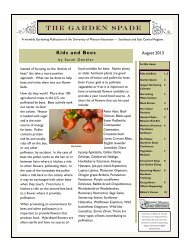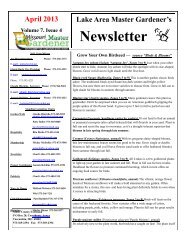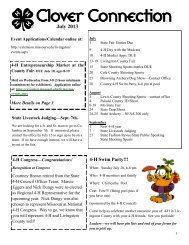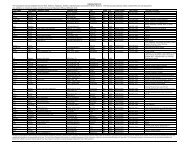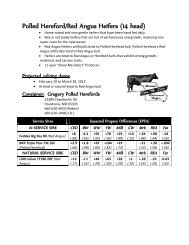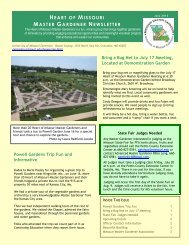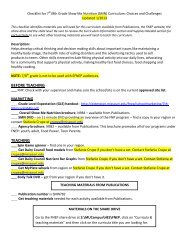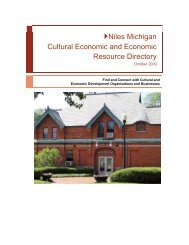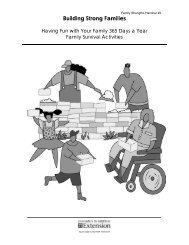Wrapping the trunks of small trees in your yard (PDF) - University of ...
Wrapping the trunks of small trees in your yard (PDF) - University of ...
Wrapping the trunks of small trees in your yard (PDF) - University of ...
Create successful ePaper yourself
Turn your PDF publications into a flip-book with our unique Google optimized e-Paper software.
Greenwald 2013<br />
Red maples are susceptible to w<strong>in</strong>ter frost crack<strong>in</strong>g and sunscald<br />
t is a common sight to see red maples along a walk<strong>in</strong>g path or sidewalk <strong>in</strong> an urban sett<strong>in</strong>g with one side <strong>of</strong><br />
<strong>the</strong> bark damaged and cracked. When I was go<strong>in</strong>g to school at Missouri State <strong>University</strong> <strong>in</strong> Spr<strong>in</strong>gfield,<br />
Missouri, <strong>the</strong>re was one maple <strong>in</strong> particular which I passed every morn<strong>in</strong>g that seemed to be eaten away on<br />
one side; with only a th<strong>in</strong> section <strong>of</strong> <strong>the</strong> trunk and bark rema<strong>in</strong><strong>in</strong>g. The cause <strong>of</strong> this ailment was not a liv<strong>in</strong>g<br />
disease, but actually <strong>the</strong> environment. The w<strong>in</strong>ter is a harsh time <strong>of</strong> year and can put a great deal <strong>of</strong> stress on<br />
sapl<strong>in</strong>g <strong>trees</strong> with th<strong>in</strong> bark. This week’s article is on protect<strong>in</strong>g <strong>trees</strong> from <strong>the</strong> harsh effects <strong>of</strong> fluctuat<strong>in</strong>g<br />
w<strong>in</strong>ter temperatures.<br />
Has a <strong>the</strong> bark <strong>of</strong> a young red maple, fruit tree, or o<strong>the</strong>r th<strong>in</strong> bark tree <strong>in</strong> <strong>your</strong> <strong>yard</strong> appeared to crack and split<br />
on <strong>the</strong> southwest side dur<strong>in</strong>g <strong>the</strong> w<strong>in</strong>ter leav<strong>in</strong>g it gashed and callused? Just like <strong>the</strong> tree I passed <strong>in</strong><br />
Spr<strong>in</strong>gfield, this damage to <strong>the</strong> southwestern side <strong>of</strong> th<strong>in</strong> barked <strong>trees</strong> is called sunscald <strong>in</strong>jury and is caused by<br />
warm w<strong>in</strong>ter sunlight and temperature fluctuations.<br />
The problem is that dur<strong>in</strong>g <strong>the</strong> late w<strong>in</strong>ter, <strong>in</strong> <strong>the</strong> Missouri Ozarks<br />
we tend to have drastic temperature sw<strong>in</strong>gs all with<strong>in</strong> a few hours<br />
<strong>of</strong> time, it can be sunny and 63 degrees one afternoon, and 28 <strong>the</strong><br />
next with temperatures dropp<strong>in</strong>g to 16 degrees at night. These<br />
changes <strong>in</strong> temperature place stress on <strong>the</strong> cells under <strong>the</strong> bark <strong>of</strong><br />
<strong>the</strong> <strong>trees</strong>, especially th<strong>in</strong> barked <strong>trees</strong> like red maple. This stress is<br />
<strong>of</strong>ten is too much for even cold hardy native tree species to<br />
endure without damage. Accord<strong>in</strong>g to Colorado State Extension,<br />
sunscald <strong>in</strong>jury is most prevalent on <strong>the</strong> southwestern side <strong>of</strong><br />
<strong>trees</strong> because that is <strong>the</strong> side <strong>of</strong> <strong>the</strong> tree which receives <strong>the</strong> most<br />
sunlight and when it warms that side <strong>of</strong> <strong>the</strong> tree is tricked <strong>in</strong>to<br />
break<strong>in</strong>g dormancy, only to be devastated when temperatures<br />
plummets and its bark cools to actually normal frigid<br />
temperatures.<br />
Stressed <strong>trees</strong> whose cells have been damaged by <strong>the</strong> warm to<br />
cold temperature changes can appear as if <strong>the</strong>ir bark has been<br />
Cracked and peal<strong>in</strong>g bark is a<br />
symptom <strong>of</strong> w<strong>in</strong>ter sunscald<br />
damage.
Greenwald 2013<br />
gashed, and cut as o<strong>the</strong>r necrotic callused tissue forms. Trees which do not succumb to disease pressure from<br />
<strong>the</strong>se open wounds, survive for years to come <strong>in</strong> this damage state.<br />
Utah State <strong>University</strong> Extension recommends wrapp<strong>in</strong>g <strong>trees</strong> <strong>in</strong> <strong>the</strong> fall with white tree wrap to prevent <strong>the</strong><br />
bark <strong>of</strong> <strong>the</strong> <strong>trees</strong> fac<strong>in</strong>g southwest from warm<strong>in</strong>g too much <strong>in</strong> <strong>the</strong> late w<strong>in</strong>ter; help<strong>in</strong>g to keep <strong>the</strong> bark cool,<br />
dormant, and free <strong>of</strong> cracks and dead damage tissue. When wrapp<strong>in</strong>g a young sou<strong>the</strong>rn magnolia back home, I<br />
tucked <strong>the</strong> corner <strong>of</strong> <strong>the</strong> warp securely under itself to hold it <strong>in</strong> place. S<strong>in</strong>ce our last frost is around April 15 th -<br />
20 th , wait to remove <strong>the</strong> warp till after this date.<br />
If <strong>the</strong> proper step is taken to limit w<strong>in</strong>ter cold <strong>in</strong>jury to <strong>small</strong> <strong>trees</strong>, southwest <strong>in</strong>jury and frost cracks can be<br />
avoided. 12<br />
1 http://extension.usu.edu/files/publications/factsheet/nr_ff_021pr.pdf<br />
2 http://www.ext.colostate.edu/ptlk/2111.html



